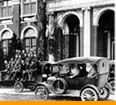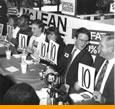About the College
College of Agriculture
| About | Students | Future Students | Alumni | Faculty/Staff |
History
The College of Agriculture traces its roots back to 1872 with the establishment of the Alabama Agricultural and Mechanical College as a land-grant college. Throughout its 139-year history, the college has helped advance Alabama's agricultural economy while improving the nutrition, health and standard of living for all citizens.
Important Dates
1859 |
|||||
| East Alabama Male College, located in Auburn, opens its doors on October 1, 1859 with enrollment of 193 and a faculty of six. | 1871 |
||||
| Forced to close in 1862 because of the Civil War, the college transfers its property for the establishment of a Land-Grant college, Alabama Agricultural and Mechanical College. | |||||
1883 |
|||||
Old Main, the predecessor to Samford Hall, as it appeared to Alabama A&M students in 1883. |
 |
||||
| 1893 |
|||||
| Charles A. Cary brought physiology and veterinary medicine to the agricultural curriculum. |
 |
||||
1910 |
|||||
Comer Hall was named for Governor B.B. Comer after it was completed in 1910. It was described as a "handsome and commodious buidling." |
 |
||||
| 1912 |
|||||
| Frances Camp Duggar
was identified in the 1912 Glomerata as Auburn's "first agricultural coed." |
 |
||||
1916 |
|||||
Chemistry and Pharmacy were part of the College of Agricultural Sciences. Many agriculture courses were taught in the newly formed Department of Agronomy. |
 |
||||
| 1918 |
|||||
| A 1918
entomology
class posed
aboard an open truck before leaving Ag Hill for a field trip to Opelika. |
 |
||||
1921 |
|||||
Bennett B. Ross,
the first Dean
of Agricultural Sciences,
served from 1908 to 1921 |
 |
||||
| 1933 |
|||||
| H.S. Swingle and E.V. Smith were project leaders for the first farm pond study conducted in the 1930s. |  |
||||
1937 |
|||||
Lack of funds made teaching difficult during the depression years. These students borrowed microscopes from Comer Hall to take to their classes. |
 |
||||
| 1946 |
|||||
| Ninety-three war- surplus tugboat deckhouses, set up with a central bath house, provided living space for 186 male students following World War II. |  |
||||
1950 |
|||||
Under the leader- ship of W.D. Salmon, left, the Department of Animal Husbandry was rated next to the University of Wisconsin in biochemistry. |
 |
||||
| 1954 |
|||||
| Auburn's
Soil
Testing Laboratory went into operation in a basement room of Extension Hall. |
 |
||||
1972 |
|||||
R. Dennis Rouse, who served as Dean from 1972 to 1980, established the Ag Alumni Association, added many agricultural facilities and programs, and helped to write the 1977 U.S. Farm Bill. |
 |
||||
| 1983 |
|||||
| A marker on the huge rock known as "Buck's Boulder" recognized the centennial year of the establishment of the Alabama Agricultural Experiment Station. |  |
||||
1984 |
|||||
| Fisheries Department Head Wayne Shell, left, and AU President James Martin were at the United Nations press conference to announce the establishment of an international fisheries information network at Auburn. |  |
||||
| 1988 |
|||||
| The "Old
Rotation"
experiment, established on the Agronomy Farm by J.F. Duggar in 1896, was added to the National Register of Historic Places. |
 |
||||
1990 |
|||||
| Auburn-developed McLean Deluxe hamburger gets a taste test at the Auburn McDonald's. |
 |
|
|||
Text condensed from Inside Ag Hill by Joe Yeager and Gene Stevenson. Images from AU Library Archives
1912, 1950, 1990.
Last Updated: May 07, 2014





